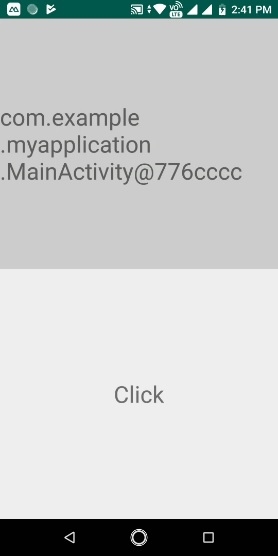
 Data Structure
Data Structure Networking
Networking RDBMS
RDBMS Operating System
Operating System Java
Java MS Excel
MS Excel iOS
iOS HTML
HTML CSS
CSS Android
Android Python
Python C Programming
C Programming C++
C++ C#
C# MongoDB
MongoDB MySQL
MySQL Javascript
Javascript PHP
PHPPhysics
Chemistry
Biology
Mathematics
English
Economics
Psychology
Social Studies
Fashion Studies
Legal Studies
- Selected Reading
- UPSC IAS Exams Notes
- Developer's Best Practices
- Questions and Answers
- Effective Resume Writing
- HR Interview Questions
- Computer Glossary
- Who is Who
How to use context in a fragment?
This example demonstrate about How to use context in a fragment
Step 1 − Create a new project in Android Studio, go to File ⇒ New Project and fill all required details to create a new project.
Step 2 − Add the following code to res/layout/activity_main.xml.
<?xml version="1.0" encoding="utf-8"?> <LinearLayout xmlns:android="http://schemas.android.com/apk/res/android" android:orientation="vertical" android:layout_width="match_parent" android:layout_height="match_parent"> <LinearLayout android:id="@+id/linearlayout01" android:layout_width="fill_parent" android:layout_height="fill_parent" android:background="#ccc" android:layout_weight="1" android:orientation="vertical"> <fragment android:name="com.example.myapplication.FirstFragment" android:id="@+id/frag_1" android:layout_width="fill_parent" android:layout_height="fill_parent" /> </LinearLayout> <LinearLayout android:id="@+id/linearlayout02" android:layout_width="fill_parent" android:layout_height="fill_parent" android:layout_weight="1" android:background="#eee" android:orientation="vertical"> <fragment android:name="com.example.myapplication.SecondFragment" android:id="@+id/frag_2" android:layout_width="fill_parent" android:layout_height="fill_parent" /> </LinearLayout> </LinearLayout>
In the above code, we have taken two fragments.
Step 3 − Add the following code to src/MainActivity.java
package com.example.myapplication;
import android.os.Bundle;
import android.support.v4.app.FragmentActivity;
public class MainActivity extends FragmentActivity {
@Override
public void onCreate(Bundle savedInstanceState) {
super.onCreate(savedInstanceState);
setContentView(R.layout.activity_main);
}
}Step 4 − Add the following code to src/ FirstFragment.java
package com.example.myapplication;
import android.os.Bundle;
import android.support.v4.app.Fragment;
import android.view.LayoutInflater;
import android.view.View;
import android.view.ViewGroup;
import android.widget.TextView;
public class FirstFragment extends Fragment {
@Override
public View onCreateView(LayoutInflater inflater, ViewGroup container, Bundle savedInstanceState) {
ViewGroup root = (ViewGroup) inflater.inflate(R.layout.fragment, null);
TextView but = (TextView) root.findViewById(R.id.text);
but.setText(""+getActivity());
return root;
}
}Step 4 − Add the following code to src/ SecondFragment.java
package com.example.myapplication;
import android.os.Bundle;
import android.support.annotation.NonNull;
import android.support.annotation.Nullable;
import android.support.v4.app.Fragment;
import android.view.LayoutInflater;
import android.view.View;
import android.view.ViewGroup;
import android.widget.TextView;
public class SecondFragment extends Fragment {
TextView textView;
View view;
@Nullable
@Override
public View onCreateView(@NonNull LayoutInflater inflater, @Nullable ViewGroup container, @Nullable Bundle savedInstanceState) {
view = inflater.inflate(R.layout.fragment, container, false);
return view;
}
}Let's try to run your application. I assume you have connected your actual Android Mobile device with your computer. To run the app from android studio, open one of your project's activity files and click Run ![]() icon from the toolbar. Select your mobile device as an option and then check your mobile device which will display your default screen –
icon from the toolbar. Select your mobile device as an option and then check your mobile device which will display your default screen –

Click here to download the project code

